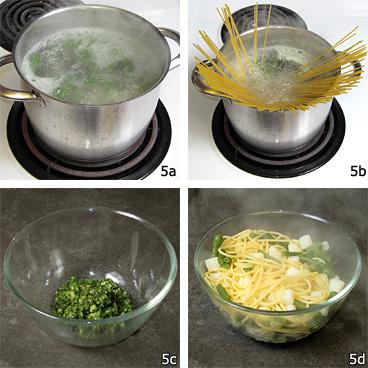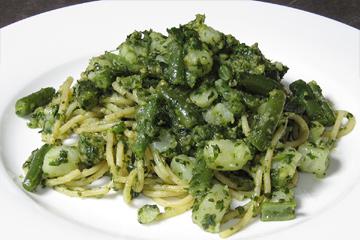 This article is about pesto, the second most famous Italian pasta sauce, after the tomato one.
This article is about pesto, the second most famous Italian pasta sauce, after the tomato one.However, this is not about the super-traditional way to make "Pesto Genovese" - using a mortar; there's plenty of good resources on that (as greatly summarized on Food Lover's Odyssey). This article is about the more modern way to make pesto - using a blender, a method which is quite common also in Italy.
Technically the word "pesto" comes from the Italian 'pestare', to pound. Therefore, the purists would argue that this sauce should be called differently when made in a blender (some jokingly suggest 'frullo', from 'frullare' to mix in a blender).
Aside from how it should be called, does the pesto made in a blender taste the same as the traditional one? Absolutely not. But it does get close, and it's still way better than any pesto that can be bought in a jar (even from Italian brands).
But before we start throwing basil leaves into the blender, it's important to know that cut basil is prone to oxidation - it turns dark when in contact with the oxygen in the air. And this causes the flavor to deteriorate. Luckily oxidation can be countered by following two simple rules.
First rule. The basil leaves must be completely dry.
- The oil used in the sauce can effectively create a seal around the basil and keep the oxygen away.
- Oil and water don't mix - in order for the oil to coat the basil, the basil must be completely dry.
Second rule. The blender must be activated in pulses.
- The blender's blades, when spinning quickly, cause a lot of friction.
- Friction causes heat, and heat favors oxidation.
With this in mind, here is how to properly make pesto in a blender.
~~~~~
Pesto Sauce
Ingredients for 4 people
Although the different recipes call for different quantities, they all gravitate around the same ingredients. Here they are in their common proportions:
- 100 g fresh basil leaves (if you can find it, prefer the one from Northern Italy - other kinds have an undesired minty flavor)
- 50 g Parmigiano (or a mix of Parmigiano & Pecorino cheese)
- 25 g pine nuts (possibly, from the Mediterranean)
- ½ cup extra-virgin olive oil (ideally, the delicate one from Liguria, pesto's homeland)
- 1 teaspoon of coarse salt
- 1 clove of garlic (optional)
Preparation
- Gently wash the basil under cold running water and then lay it on a towel and let it dry completely (fig. 1). Do not bend or crush the leaves.
 - Meanwhile, put the blender's bowl and blade in the freezer for at least 10 minutes (fig. 2a).
- Meanwhile, put the blender's bowl and blade in the freezer for at least 10 minutes (fig. 2a).- Pour all of the oil in the blender, then add the crushed garlic (if using it) and the basil. Give it a few pulses until the leaves are roughly chopped up (fig. 2b).
- Add the cheese, grated or cut in small bits, and the salt (fig. 2c). Give it a few more spins.
- Add the whole pine nuts (fig. 2d). Give a few last spins and extract from the blender (fig. 3).
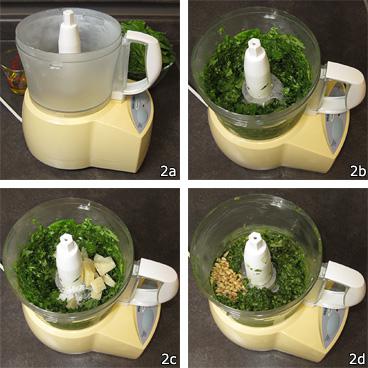
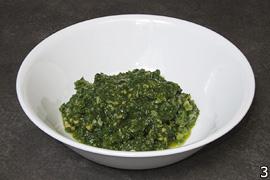
If the sauce is not used immediately, it can be preserved in the fridge for up to two to three days. Store it in a tall and narrow container (e.g.: a glass) and top it up with an extra tablespoon of olive oil. Before using it, leave the sauce out of the fridge an hour - don't warm it up, or you'll cause the cheese to lump together and separate from the oil. Pesto can also be frozen, in that case some recommend not to add the cheese until the sauce is thawed.
~~~~~
Pasta with Pesto, Potatoes and Green Beans
Now onto a common variation to the classic pesto pasta, represented in the top picture. In Liguria, pesto pasta is often had along with potatoes and green beans (this hearty version is sometimes called 'enriched' pesto).
Ingredients for 4 people
- pesto sauce for 4 people
- 1 russet potato (about 250 g in weight)
- 150 g of green beans
- 250 g of pasta (trofie is the most traditional, linguine or spaghetti are also common).
Preparation
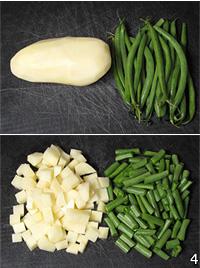 - Dice the potato and cut the green beans in bite-size chunks (fig. 4).
- Dice the potato and cut the green beans in bite-size chunks (fig. 4).- Drop the green beans in a large pot of salted boiling water, cook for 10 minutes (fig. 5a).
- Dried pasta generally takes the same cooking time as the diced potatoes (about 10 minutes). If using dried pasta, add it along with the potato (fig. 5b) and cook for the time indicated on the box. If using fresh pasta, start by adding the potatoes, boil for 7-8 minutes, then add the pasta and cook for another 2 or 3.
- Put a good tablespoon of pesto in each plate and dilute it with some of the pasta cooking water (fig. 5c).
- When the pasta and vegetables is ready, quickly drain it, pour it on top of the pesto (fig. 5d) and stir gently.
- Serve immediately in warmed-up plates.
